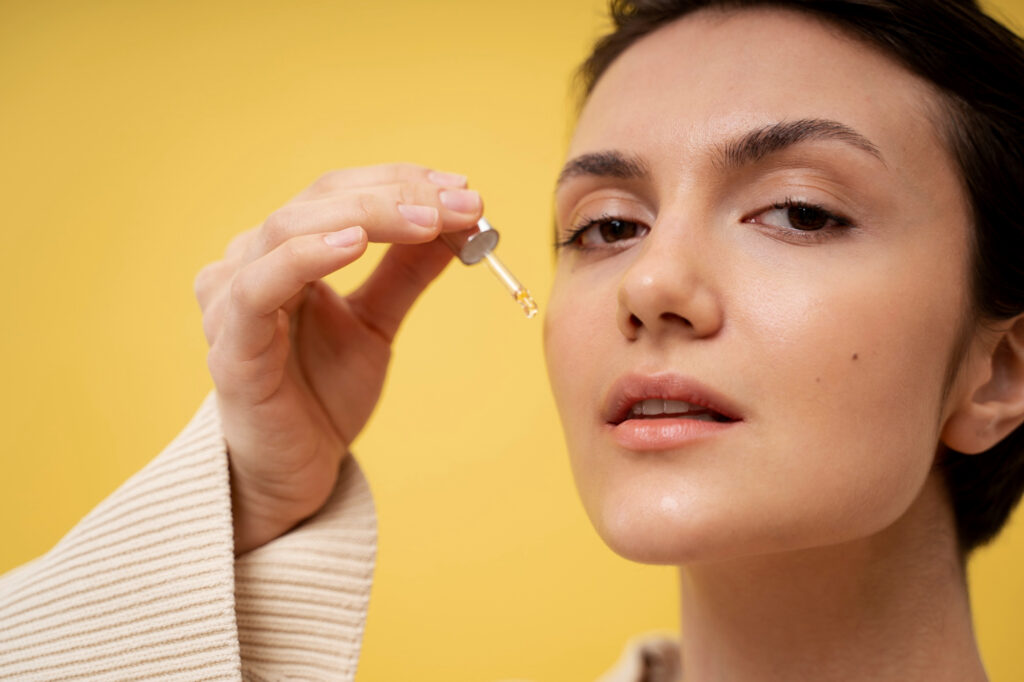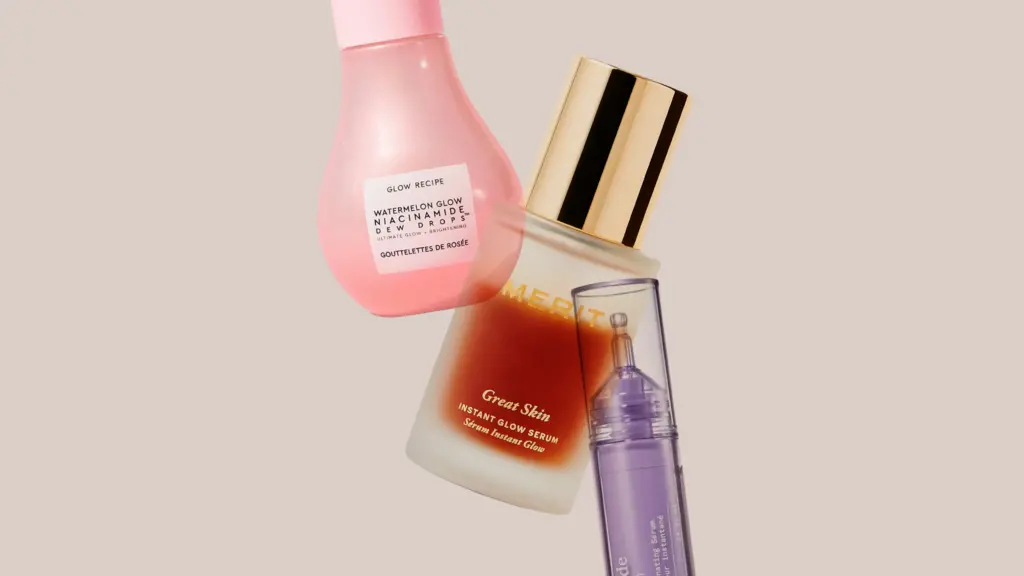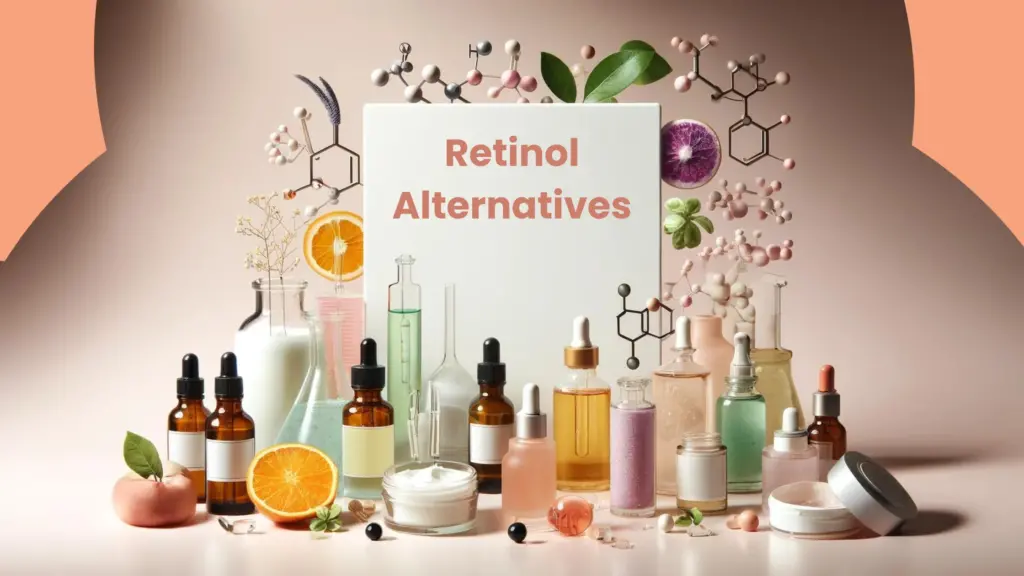
Ever looked in the mirror and wished your skin looked a bit brighter, smoother, and younger? You’re not alone! That’s where powerful ingredients like retinol and niacinamide come in. But with so many skincare products out there, you might wonder: can you use retinol and niacinamide together?
The answer is yes, but there’s more to the story! This article dives into the world of retinol and niacinamide, exploring their individual benefits, potential drawbacks, and the best ways to use them together for a radiant complexion.
What is Retinol?
Retinol, a form of vitamin A, is a superstar ingredient in the anti-aging world. Here’s how it works its magic:
- Boosts Collagen Production: Collagen is a protein that keeps your skin plump and youthful. Retinol encourages your skin to produce more collagen, reducing the appearance of wrinkles and fine lines.
- Targets Hyperpigmentation: Uneven skin tone and dark spots? Retinol can help! It helps regulate melanin production, which can lighten hyperpigmentation and brighten your complexion.
- Minimizes Pores: Large pores can be a concern. Retinol can help shrink the appearance of pores for a smoother-looking skin texture.

But Retinol Can Be a Little Demanding:
While powerful, retinol can also be irritating, especially for beginners. Here’s what to watch out for:
- Dryness and Flaking: Retinol can increase skin cell turnover, sometimes leading to temporary dryness and flaking.
- Increased Sun Sensitivity: Retinol makes your skin more sensitive to the sun. Consistent sunscreen use (SPF 30 or higher) is crucial when using retinol.
Also Read: How to Use Vitamin C for Dark Spots: Fading Sun Damage and Evening Your Skin Tone
What is Niacinamide?
Niacinamide, a form of vitamin B3, is another hero ingredient with a wide range of benefits:
- Reduces Redness and Inflammation: Struggling with redness or irritation? Niacinamide can help soothe your skin and calm inflammation.
- Minimizes Pores: Similar to retinol, niacinamide can help minimize the appearance of enlarged pores, giving your skin a smoother texture.
- Strengthens Skin Barrier: Niacinamide helps strengthen your skin’s natural barrier, which helps retain moisture and protects it from environmental damage.
Niacinamide: Generally Gentle and Easygoing
Unlike retinol, niacinamide is generally well-tolerated by most skin types. It’s a gentle ingredient that can work wonders on even sensitive skin.
The Benefits of Combining Retinol and Niacinamide:
So, can you use retinol and niacinamide together? Absolutely! In fact, using them together can offer some amazing benefits for your skin:

- Dream Team for Anti-Aging: Retinol tackles wrinkles and hyperpigmentation, while niacinamide calms and strengthens the skin. Together, they create a powerful anti-aging duo.
- Reduced Irritation: Niacinamide might help soothe some of the dryness and irritation caused by retinol, making it more tolerable for beginners.
- Enhanced Effects: Studies suggest that combining these ingredients might even enhance their individual benefits for your skin.
How to Use Retinol and Niacinamide Together:
While they can be a powerhouse team, using retinol and niacinamide together requires a strategic approach:
- Start Slow: If you’re new to retinol, introduce it gradually. Start with using it 1-2 times a week at night and see how your skin reacts.
- Moisturize: Both retinol and niacinamide can be drying, so using a good moisturizer is essential. Apply moisturizer after your retinol or niacinamide treatment.

- Sunscreen is a Must: Retinol increases sun sensitivity. Always wear sunscreen with SPF 30 or higher every day, even on cloudy days.
- Consider Separate Products: You can use separate products containing retinol and niacinamide in your routine. Apply the gentler niacinamide first, followed by retinol at night.
- Consult a Dermatologist: Unsure how to use these ingredients or have concerns? Consult a dermatologist for personalized advice.
Important Considerations:
Here are some additional things to keep in mind when using retinol and niacinamide:
- Patch Test: Before applying any new product to your face, do a patch test on a small area of your arm to check for any allergic reactions.
- Listen to Your Skin: Everyone’s skin reacts differently. If you experience excessive dryness, redness, or irritation, take a break from these ingredients and consult a dermatologist.
- Patience is Key: Don’t expect overnight results. It takes time for these ingredients to work their magic. Be consistent with your routine and you’ll see gradual improvement.
Also Read: The Ultimate Guide to Choosing the Best Plum Face Wash for Oily Skin
Alternative Ingredients for Sensitive Skin and Other Concerns
While retinol and niacinamide are powerful ingredients, they might not be suitable for everyone. Here are some alternatives to consider:
Alternatives for Retinol:
- Bakuchiol: This plant-based ingredient is often called a “natural retinol” because it offers some similar benefits, like boosting collagen production and reducing wrinkles, but is generally gentler on the skin.

- Peptides: Peptides are small protein fragments that can signal your skin to produce more collagen and elastin, leading to a firmer, plumper appearance.
- Alpha Hydroxy Acids (AHAs): AHAs, like glycolic acid and lactic acid, can help exfoliate dead skin cells, brighten the complexion, and reduce the appearance of wrinkles.
Alternatives for Niacinamide:
- Azelaic Acid: This ingredient can help reduce redness, inflammation, and hyperpigmentation. It’s a good option for those with rosacea or acne-prone skin.
- Centella Asiatica (Cica): Cica is a popular Korean skincare ingredient known for its calming and soothing properties. It can help reduce redness and irritation and promote skin healing.
- Green Tea Extract: Green tea extract is rich in antioxidants that can help protect your skin from environmental damage and reduce inflammation.
Remember: When choosing alternative ingredients, consult a dermatologist or esthetician for personalized recommendations based on your specific skin concerns.
Also Read: The Secret Weapon for Glowing Skin: 10 Best Products to Support Your Skin Microbiome
Sunscreen: Your Best Friend, No Matter What!
Regardless of whether you use retinol, niacinamide, or alternative ingredients, sunscreen is an absolute must-have in your skincare routine. Here’s why:
- Prevents Sun Damage: Sun exposure is a major contributor to wrinkles, hyperpigmentation, and skin cancer. Daily sunscreen use with SPF 30 or higher is essential for protecting your skin.
- Complements Other Ingredients: Sunscreen helps maximize the benefits of other skincare ingredients like retinol and niacinamide.
Conclusion: Finding the Right Skincare Routine for You
The world of skincare can be overwhelming, but with the right information, you can build a routine that works wonders for your skin. Here are some key takeaways:
- Retinol and niacinamide can be a powerful combination for anti-aging and improving skin texture.
- Start slow and listen to your skin when incorporating these ingredients.
- Consider alternative ingredients if you have sensitive skin or other concerns.
- Sunscreen is a non-negotiable part of any healthy skincare routine.
By understanding the benefits and potential drawbacks of retinol and niacinamide, along with exploring alternative ingredients and the importance of sunscreen, you can make informed choices for a glowing, healthy complexion. Remember, consistency is key! Stick with your skincare routine and enjoy the journey to radiant skin.
Additional Resources:
- American Academy of Dermatology (AAD): https://www.dermatologytimes.com/view/anti-aging-skin-care-tips-from-aad This AAD resource provides an overview of retinol and its uses.
- Paula’s Choice: https://www.paulaschoice.com/skin-care-advice/retinol/can-retinol-and-niacinamide-be-used-together This article by Paula’s Choice dives deeper into using retinol and niacinamide together.
- National Cancer Institute: https://www.ncbi.nlm.nih.gov/pmc/articles/PMC2564815/ This National Cancer Institute resource provides information on sun protection and how to prevent skin cancer.
Can You Use Retinol and Niacinamide Together? – FAQs
Yes, you can use retinol and niacinamide together! In fact, this combination can be incredibly beneficial for your skin. This FAQ section dives into the specifics of using these ingredients together, addressing common concerns and helping you get the most out of this skincare power duo.
- Isn’t retinol harsh on the skin? Won’t it irritate my skin if I use it with niacinamide?
Retinol can be irritating, especially for beginners. However, niacinamide might actually help! Here’s why:
- Niacinamide Can Soothe: Niacinamide has anti-inflammatory properties that can help calm redness and irritation caused by retinol.
- Gentler Introduction: By incorporating niacinamide into your routine alongside retinol, you might be able to introduce retinol gradually and minimize irritation.
- Okay, so how exactly should I use retinol and niacinamide together?
Here’s a breakdown of how to incorporate these ingredients into your routine:
- Start Slow: Begin with using retinol 1-2 times a week at night. If your skin tolerates it well, you can gradually increase the frequency.
- Niacinamide First: Apply niacinamide first, followed by retinol. Niacinamide’s gentler nature makes it a good base for the potentially stronger retinol.
- Moisturize: Since both retinol and niacinamide can be drying, using a good moisturizer is crucial. Apply moisturizer after your retinol or niacinamide treatment.
- Sunscreen is Essential: Remember, retinol increases sun sensitivity. Always wear sunscreen with SPF 30 or higher every day, even on cloudy days.
- Should I use a product with both retinol and niacinamide, or can I use separate products?
Both options work! Here’s what to consider:
- Separate Products: Many people prefer using separate serums or creams containing retinol and niacinamide. This allows for more control over the application and concentration of each ingredient.
- Combination Products: There are also products available that combine retinol and niacinamide in one formula. This can be convenient, but make sure the concentration of retinol is suitable for your skin’s sensitivity.
- My skin is very sensitive. Can I still use retinol and niacinamide?
It depends. While niacinamide is generally well-tolerated, even by sensitive skin, retinol might be too harsh. Here are some alternatives:
- Consult a Dermatologist: A dermatologist can recommend alternative ingredients or formulations that are gentler on sensitive skin.
- Consider Bakuchiol: Bakuchiol is a plant-based ingredient with some anti-aging benefits similar to retinol, but it’s often gentler.
- Focus on Niacinamide: If your skin can’t handle retinol, focus on niacinamide for its calming and pore-minimizing benefits.
- I haven’t seen any results yet. How long does it take for retinol and niacinamide to work?
Be patient! It takes time for these ingredients to show their magic. Here’s what to expect:
- Give it Time: It can take 4-8 weeks to see noticeable improvements with retinol and niacinamide.
- Consistency is Key: Use these ingredients consistently for optimal results. Don’t get discouraged if you don’t see overnight changes.
- What if I experience excessive dryness, redness, or irritation when using retinol and niacinamide together?
If you experience significant irritation, take a break from these ingredients and consult a dermatologist. Here are some additional tips:
- Reduce Frequency: Try using retinol less frequently or dilute it with moisturizer before application.
- Moisturize More: Increase your moisturizer usage to combat dryness caused by retinol and niacinamide.
- Patch Test: Always do a patch test before applying any new product to your entire face.
- Are there any ingredients that don’t work well with retinol and niacinamide?
While retinol and niacinamide generally play well together, there are some exceptions:
- Limit AHAs: Avoid using strong Alpha Hydroxy Acids (AHAs) like glycolic acid too close to the time you use retinol, as it can further increase irritation.
- Be Cautious with Vitamin C: Vitamin C serums can sometimes interact with retinol, so it’s best to use them at different times of the day (vitamin C in the morning, retinol at night).
- Can I use retinol and niacinamide around my eyes?
The skin around the eyes is very delicate. While some people tolerate retinol and niacinamide around the eyes, it’s best to proceed with caution:
- Look for Eye-Specific Products: There are specific eye creams formulated with gentler retinol or retinol alternatives that might be suitable for the delicate under-eye area.
- Test on a Small Area: If you decide to use your regular retinol or niacinamide product around your eyes, do a patch test first and monitor for any irritation.
- Is it okay to use retinol and niacinamide while pregnant or breastfeeding?
It’s best to consult your doctor before using retinol and niacinamide while pregnant or breastfeeding. Some resources suggest avoiding retinol altogether during this time due to potential risks.
- Where can I find good quality retinol and niacinamide products?
Retinol and niacinamide are widely available in various skincare products. Here are some tips for finding good quality options:
- Look for Reputable Brands: Choose established brands known for their quality control and responsible sourcing of ingredients.
- Read Reviews: Check online reviews from other users to get insights into different products.
- Consider Consulting a Dermatologist: A dermatologist can recommend products based on your specific skin type and concerns.


